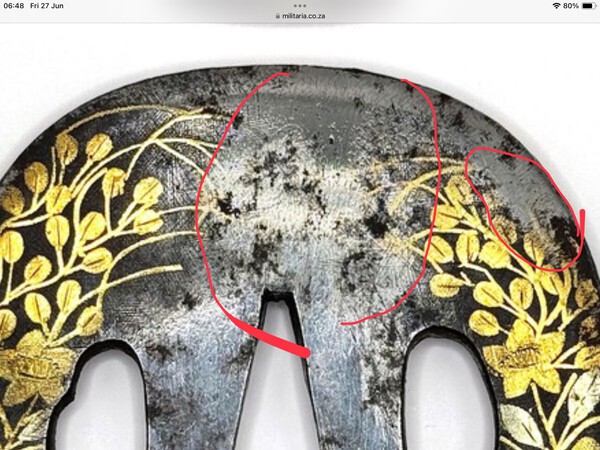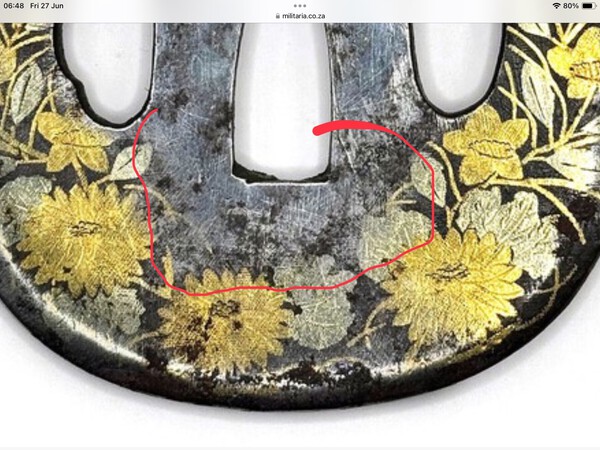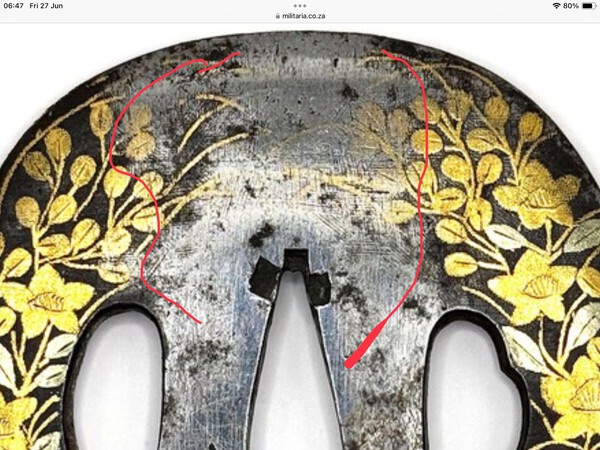
Matsunoki
Gold Tier-
Posts
3,371 -
Joined
-
Last visited
-
Days Won
61
Content Type
Profiles
Forums
Events
Store
Downloads
Gallery
Everything posted by Matsunoki
-
Are there any statistical records of the metalurgical constituents of iron tsuba from different periods?
-
I have read the original post a few times now and I cannot see where Colin has had a question about it’s iron makeup. Colin was rightly confident that it was genuine and this has been confirmed by several members. Why on earth would he want to subject it to any tests? What are you expecting such tests to reveal?
-
Mismatched fittings, saya and ito look brand new. Nakago looks wrong, habaki looks hammered. What type of hamon?…..my guess a Chinese hamon on a fake blade in a made up Koshirae all designed to fool. imo
-
The shiny one may well have a wax coating or sometimes oil is used. It’s nothing to worry about and I’d leave it alone. Sometimes you can do more harm than good trying to clean things. Both tsuba have what looks like nunome zogan work on the rims and that is easily damaged so again, leave them alone. The shine may fade with time. Keep them dry and check for fresh rust every now and then As background reading just put “basket weave tsuba” into the search box on this forum, click on “everywhere” and I’m sure you’ll find lots to think about and compare to.
-
Spot on Jeff. Why punish the guilty few when you punish the many innocents. Send a few of the smugglers to jail for a good stretch and that might just deter a few.…..or prosecute the local “officials” who are in on the illegal exports. It’s riddled with corruption. Never mind, let’s be seen to do something even if it is unworkable. Arghhhhhh, makes me so mad.
-
Justyn, I’m sorry to be the bearer of bad news. I wish you well in your dispute with the Auctioneers. If it would help in any way you can use anything I have said…you can quote me exactly and I am happy to email them directly if it will help. Good luck.
-
Thanks Desmond. I have mentioned this legislation a couple of times on the Forum but I think it is largely going un-noticed and there are going to be many EU collectors with serious trouble on their hands. Swords stuck all over the world but especially in Japan whether with Japanese dealers or for Shinsa. It is bureaucracy gone totally mad. I’m exactly the opposite!…for better or worse! My days dealing in Japanese Art taught me not to hesitate. “The time to buy something good is when you see it” was the advice I was given very early on. When that approach does backfire on you simply sell it, forget it and go buy something else! I remember several instances when I’ve been standing behind someone at a show or a fair. He has picked up something really nice and is pontificating and trying to talk it down. I’m praying “please just put it down and go think about it”….and the utter joy when he puts it down and says he’ll be back in a few minutes…..and the look of horror when I pick it up and say “sold”. It’s dog eat dog out there! Who dares wins (most of the time🙂) I once had a fight break out on my stand at a large show caused by just such an event. Anyway what’s that got to do with anything…..🙂, sorry.
-
Trouble is we are not part of EU now so bringing anything in using any method attracts customs duties even from Europe …..that then brings into question having to prove the age etc. Antique is 5% but otherwise it’s 20%…..and in my experience they apply 20% and it’s up to you to prove otherwise. Also if you risk it by not declaring it and get caught it’s probably bye bye sword. Alex is right re his views on this country…..so disappointing and depressing.
-
We’ll to my (old) eyes the iron surface AND the nunome has been very heavily abraded…..see circled areas in red. The nunome has virtually disappeared and where it remains it is very weak. Also imo the Japanese would never put silver nunome onto a silver(ed) surface…..what would be the point? It would not show up. Not the sort of artistic blunder that the Japanese would ever make. Also imo we can see the remains of deep pitting in several areas especially where the surface has been abraded suggesting very nasty corrosion had existed. Also, in areas where there is no abrasion to the plate or the nunome the surface colour does not suggest tarnished silver, it looks exactly as it should ie patinated iron. Im not trying to score points but if someone is spending substantial money on these things it is useful to understand what we are looking at…..and why it looks as it does….and best not to rely on what any Auctioneer says.
-
I’m struggling to believe this is silvered. The silver colour looks like heavily worn shiny iron ie it has lost all of it original dark patina. Personally I’ve never ever seen nunome zogan on silver or on silver plate. In this case the silver nunome would not have stood out against the background? To my eyes it is a heavily abraded and worn iron plate that just happens to look like it’s been silvered. I hope i am wrong because that’s a hell of a price for a worn iron tsuba.
-
The two overlapping plaques remind me of those that are found on Torii at Shrine entrances…..try putting an image on the translation section. eg…
-
Ian, have you got images of the whole tsuba?
-
Be a bit clearer and tell us why.
-
Help please on tsuba box inscriptions
Matsunoki replied to Matsunoki's topic in Translation Assistance
@Nobody Moriyama san, very kind of you. Many thanks. Best. C. -
Lovely to see such skill. You should be very proud. Congrats.
-
Help please on tsuba box inscriptions
Matsunoki replied to Matsunoki's topic in Translation Assistance
-
Please can you tell me what this all says on a tsuba box? Many thanks in advance….and apologies for all the shadows.
-
From these images it simply isn’t possible to tell you the age with any confidence. Read what Ray said…..that’s the opinion of a real expert and it’s the best you’ll get. Elsewhere you might get other opinions but that’s all they’ll be…opinions. The blade is in such rough shape that absolutely no detail is visible.
-
Well now we know! An old Tanto blade repurposed. Interesting and it has its own place in history. Possibly used as a multi-purpose tool rather than a gardening tool (wrong shape for that). Also, the saya is far too long and too curved to have been made for this blade so maybe it’s a marriage between an old blade and an existing mounting.
-
Hi Piers, this item is also being discussed in this thread…… Always confusing when we get two threads going on the same item…. Best.C.
-
Please show both sides of the complete nakago ie including the machi area and the jiri. From what you have shown so far the Mei is in a totally inappropriate place on the nakago and thus highly unlikely it was put there by whoever made the blade. The nakago patina suggests that it is suriage and machiokuri ie the nakago has been chopped and the machi moved up the blade.













